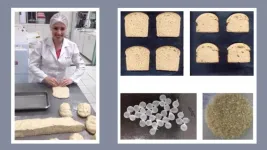(Press-News.org) A team of scientists used NASA’s James Webb Space Telescope to parse the composition of the Crab Nebula, a supernova remnant located 6,500 light-years away in the constellation Taurus. With the telescope’s MIRI (Mid-Infrared Instrument) and NIRCam (Near-Infrared Camera), the team gathered data that is helping to clarify the Crab Nebula’s history.
The Crab Nebula is the result of a core-collapse supernova from the death of a massive star. The supernova explosion itself was seen on Earth in 1054 CE and was bright enough to view during the daytime. The much fainter remnant observed today is an expanding shell of gas and dust, and outflowing wind powered by a pulsar, a rapidly spinning and highly magnetized neutron star.
The Crab Nebula is also highly unusual. Its atypical composition and very low explosion energy previously have been explained by an electron-capture supernova — a rare type of explosion that arises from a star with a less-evolved core made of oxygen, neon, and magnesium, rather than a more typical iron core.
“Now the Webb data widen the possible interpretations,” said Tea Temim, lead author of the study at Princeton University in New Jersey. “The composition of the gas no longer requires an electron-capture explosion, but could also be explained by a weak iron core-collapse supernova.”
Studying the Present to Understand the Past
Past research efforts have calculated the total kinetic energy of the explosion based on the quantity and velocities of the present-day ejecta. Astronomers deduced that the nature of the explosion was one of relatively low energy (less than one-tenth that of a normal supernova), and the progenitor star’s mass was in the range of eight to 10 solar masses — teetering on the thin line between stars that experience a violent supernova death and those that do not.
However, inconsistencies exist between the electron-capture supernova theory and observations of the Crab, particularly the observed rapid motion of the pulsar. In recent years, astronomers have also improved their understanding of iron core-collapse supernovae and now think that this type can also produce low-energy explosions, providing that the stellar mass is adequately low.
Webb Measurements Reconcile Historic Results
To lower the level of uncertainty surrounding the Crab’s progenitor star and nature of the explosion, the team led by Temim used Webb’s spectroscopic capabilities to hone in on two areas located within the Crab’s inner filaments.
Theories predict that because of the different chemical composition of the core in an electron-capture supernova, the nickel to iron (Ni/Fe) abundance ratio should be much higher than the ratio measured in our Sun (which contains these elements from previous generations of stars). Studies in the late 1980s and early 1990s measured the Ni/Fe ratio within the Crab using optical and near-infrared data and noted a high Ni/Fe abundance ratio that seemed to favor the electron-capture supernova scenario.
The Webb telescope, with its sensitive infrared capabilities, is now advancing Crab Nebula research. The team used MIRI’s spectroscopic abilities to measure the nickel and iron emission lines, resulting in a more reliable estimate of the Ni/Fe abundance ratio. They found that the ratio was still elevated compared to the Sun, but only modestly and much lower in comparison to prior estimates.
The revised values are consistent with electron-capture, but do not rule out an iron core-collapse explosion from a similarly low-mass star. (Higher-energy explosions from higher-mass stars are expected to produce ratios closer to solar abundances.) Further observational and theoretical work will be needed to distinguish between these two possibilities.
“At present, the spectral data from Webb covers two small regions of the Crab, so it’s important to study much more of the remnant and identify any spatial variations,” said Martin Laming of the Naval Research Laboratory in Washington and a co-author of the paper. “It would be interesting to see if we could identify emission lines from other elements, like cobalt or germanium.”
Mapping the Crab’s Current State
Besides pulling spectral data from two small regions of the Crab Nebula’s interior to measure the abundance ratio, the telescope also observed the remnant’s broader environment to understand details of the synchrotron emission and the dust distribution.
The images and data collected by MIRI enabled the team to isolate the dust emission within the Crab and map it in high resolution for the first time. By mapping the warm dust emission with Webb, and even combining it with the Herschel Space Observatory’s data on cooler dust grains, the team created a well-rounded picture of the dust distribution: The outermost filaments contain relatively warmer dust, while cooler grains are prevalent near the center.
“Where dust is seen in the Crab is interesting because it differs from other supernova remnants, like Cassiopeia A and Supernova 1987A,” said Nathan Smith of the Steward Observatory at the University of Arizona and a co-author of the paper. “In those objects, the dust is in the very center. In the Crab, the dust is found in the dense filaments of the outer shell. The Crab Nebula lives up to a tradition in astronomy: The nearest, brightest, and best-studied objects tend to be bizarre.”
These findings have been accepted for publication in The Astrophysical Journal Letters.
The observations were taken as part of General Observer program 1714.
The James Webb Space Telescope is the world’s premier space science observatory. Webb is solving mysteries in our solar system, looking beyond to distant worlds around other stars, and probing the mysterious structures and origins of our universe and our place in it. Webb is an international program led by NASA with its partners, ESA (European Space Agency) and CSA (Canadian Space Agency).
END
Investigating the origins of the crab nebula with NASA's Webb
2024-06-17
ELSE PRESS RELEASES FROM THIS DATE:
The KIT ligand KITLG promotes portal vein tumor thrombosis by up-regulating COL4A1 through STAT3-SMAD2 signaling in hepatocellular carcinoma
2024-06-17
https://www.scienceopen.com/hosted-document?doi=10.15212/AMM-2023-0049
Announcing a new publication for Acta Materia Medica journal. Portal vein tumor thrombosis (PVTT), a severe complication of hepatocellular carcinoma (HCC), markedly influences patient prognosis by fostering a hypercoagulable state. However, its molecular underpinnings remain largely unexplored. This study sheds light on the critical role of the KIT ligand (KITLG) in modulating expression of the collagen gene COL4A1 via the STAT3-SMAD2 signaling pathway, thereby influencing platelet activation and PVTT development. Extensive analysis of PVTT tissue samples, ...
Recent Georgia Tech grad earns ACM Doctoral Dissertation Award for creating devices that look like stickers and can harvest energy from the environment
2024-06-17
ACM, the Association for Computing Machinery, today announced that Nivedita Arora, of Northwestern University is the recipient of the ACM Doctoral Dissertation Award for her dissertation “Sustainable Interactive Wireless Stickers: From Materials to Devices to Applications,” which demonstrated wireless and batteryless sensor nodes using novel materials and radio backscatter.
Arora’s research envisions creating sustainable computational materials that operate by harvesting energy from the environment and, at the end ...
Spinning up hurricane communications
2024-06-17
Forecasters can use images in social media to better communicate weather related hazards of hurricanes, according to a pair of new studies.
Scientists at the U.S. National Science Foundation National Center for Atmospheric Research (NSF NCAR) analyzed 2017 Twitter (now X) data related to two hurricanes – Harvey and Irma. The researchers found that forecast information communicated in the early stages of storm development, when the threat posed by a hurricane is uncertain, sets the stage for how people react to subsequent ...
How the ketogenic diet improves healthspan and memory in aging mice
2024-06-17
The ketogenic diet has its fanatics and detractors among dieters, but either way, the diet has a scientifically documented impact on memory in mice. Whlie uncovering how the high fat, low carbohydrate diet boosts memory in older mice, Buck scientists and a team from the University of Chile identified a new molecular signaling pathway that improves synapse function and helps explain the diet’s benefit on brain health and aging. Published in the June 5, 2024 issue of Cell Reports Medicine, the findings provide new directions for targeting the memory effects on a molecular level, without requiring a ketogenic diet or even the byproducts of it.
“Our ...
Brazilian scientists develop functional bread to help prevent asthma
2024-06-17
Brazilian researchers have developed functional bread with the potential to prevent asthma, a respiratory disorder responsible for some 350,000 hospitalizations per year in the SUS (Sistema Único de Saúde), the nation’s public healthcare network.
The formulation, for which a patent application has been filed in Brazil (BR1020210266465), is described in an article published in the journal Current Developments in Nutrition. It contains Saccharomyces cerevisiae UFMG A-905, ...
Potential new treatment option for diabetic retinopathy
2024-06-17
Potential New Treatment Option for Diabetic Retinopathy
OU researcher developing potential new treatment for diabetic retinopathy that could address the problem much earlier.
OKLAHOMA CITY, OKLA. – Patients with diabetes face a host of potential health problems as they work to manage the chronic disease. Still, one concern that seems to weigh heavily is the risk of losing their sight through a condition known as diabetic retinopathy.
Researchers at the University of Oklahoma Health Sciences and Memorial Sloan Kettering (MSK) Cancer Center are studying a new, revolutionary treatment for diabetic retinopathy that could change the prognosis ...
Paternal use of metformin during sperm production not associated with major birth defects
2024-06-17
Embargoed for release until 5:00 p.m. ET on Monday 17 June 2024
Annals of Internal Medicine Tip Sheet
@Annalsofim
Below please find summaries of new articles that will be published in the next issue of Annals of Internal Medicine. The summaries are not intended to substitute for the full articles as a source of information. This information is under strict embargo and by taking it into possession, media representatives are committing to the terms of the embargo not ...
American diets have a long way to go to achieve health equity
2024-06-17
Poor diet continues to take a toll on American adults. It’s a major risk factor for obesity, type 2 diabetes, cardiovascular disease, and certain cancers, and more than one million Americans die every year from diet-related diseases, according to the Food and Drug Administration. Poor diet and food insecurity is also costly, attributing to an estimated $1.1 trillion in healthcare expenditures and lost productivity. These burdens also contribute to major health disparities by income, education, zip code, race, and ethnicity.
In a study from the Food is Medicine Institute at the Friedman School of Nutrition Science and Policy at Tufts University published today in ...
New ‘aging atlas’ provides a detailed map of how cells and tissues age
2024-06-17
A new aging atlas gives scientists an in-depth view of how individual cells and tissues in worms age and how different lifespan-extending strategies might stop the clock.
Aging impacts all the tissues in our body – from our muscles to our skin. Figuring out how individual tissues and cells age could help researchers better understand the aging process and aid in the development of anti-aging treatments.
Due to their short lifespans, simple body plans, and genetic similarity to humans, many researchers study aging in roundworms. To look at aging at the level of tissues and cells, a team of researchers from HHMI's Janelia ...
New technology allows researchers to precisely, flexibly modulate brain
2024-06-17
By Beth Miller
Human brain diseases, such as Parkinson’s disease, involve damage in more than one region of the brain, requiring technology that could precisely and flexibly address all affected regions simultaneously. Researchers at Washington University in St. Louis have developed a noninvasive technology combining a holographic acoustic device with genetic engineering that allows them to precisely target affected neurons in the brain, creating the potential to precisely modulate selected cell ...



